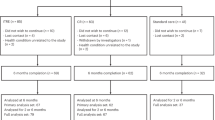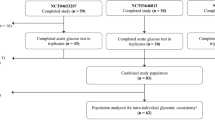Abstract
Background/Objectives
Hyperglycemia is common in critically ill patients and associated with increased mortality. It has been suggested that different nutrition formulas may beneficially influence glucose levels in surgical intensive care patients. In this prospective randomized clinical cohort study we investigated glucose homeostasis in response to different enteral nutrition formulas in medical critically ill patients.
Subjects/Methods
60 medical critically ill patients were randomized to receive continuous fat-based (group A, n = 30) or glucose-based enteral nutrition (group B, n = 30) for seven days. Indirect calorimetry was performed to determine energy demand at baseline and on days 3 and 7. Glucose levels and area under the curve (AUC), insulin demand, glucose variability, and calorie and substrate intake per 24 h were assessed for 7 days.
Results
Over the course of 7 days patients had similar average daily glucose (p = 0.655), glucose AUC (A: 758 (641–829) mg/dl/day vs B: 780 (733–845) mg/dl/day, p = 0.283), similar overall insulin demand (A: 153.5 (45.3–281.5) IE vs B: 167.9 (82.3–283.8) IE, p = 0.525), and received similar amounts of enteral nutrition per 24 h. Resting energy expenditure was similar at baseline (A: 1556 (1227–1808) kcal/day vs B: 1563 (1306–1789) kcal/day, p = 0.882) but energy expenditure increased substantially over time in group A (p < 0.0001), but not in group B (p = 0.097).
Conclusion
Fat-based and glucose-based EN influence glucose homeostasis and insulin demand similarly, yet diet-induced thermogenesis was substantially higher in critically ill patients receiving fat-based enteral nutrition.
This is a preview of subscription content, access via your institution
Access options
Subscribe to this journal
Receive 12 print issues and online access
$259.00 per year
only $21.58 per issue
Buy this article
- Purchase on SpringerLink
- Instant access to full article PDF
Prices may be subject to local taxes which are calculated during checkout


Similar content being viewed by others
Change history
06 August 2018
A correction to this article has been published.
References
Kreymann KG, Berger MM, Deutz NE, Hiesmayr M, Jolliet P, Kazandjiev G, et al. ESPEN guidelines on enteral nutrition: intensive care. Clin Nutr. 2006;25:210–23. https://doi.org/10.1016/j.clnu.2006.01.021
Singer P, Berger MM, Van den Berghe G, Biolo G, Calder P, Forbes A, et al. ESPEN guidelines on parenteral nutrition: intensive care. Clin Nutr. 2009;28:387–400. https://doi.org/10.1016/j.clnu.2009.04.024
Faisy C, Lerolle N, Dachraoui F, Savard JF, Abboud I, Tadie JM, et al. Impact of energy deficit calculated by a predictive method on outcome in medical patients requiring prolonged acute mechanical ventilation. Br J Nutr. 2009;101:1079–87. https://doi.org/10.1017/S0007114508055669
Singer P, Anbar R, Cohen J, Shapiro H, Shalita-Chesner M, Lev S, et al. The tight calorie control study (TICACOS): a prospective, randomized, controlled pilot study of nutritional support in critically ill patients. Intensive Care Med. 2011;37:601–9. https://doi.org/10.1007/s00134-011-2146-z
Anbar R. Enteral nutrition. World Rev Nutr Diet. 2013;105:50–58. https://doi.org/10.1159/000341267
Dungan KM, Braithwaite SS, Preiser JC. Stress hyperglycemia. Lancet. 2009;373:1798–807.
Zauner A, Nimmerrichter P, Anderwald C, Bischof M, Schiefermeier M, Ratheiser K, et al. Severity of insulin resistance in critically ill medical patients. Metabolism. 2007;56:1–5.
Tappy L, Schwarz JM, Schneiter P, Cayeux C, Revelly JP, Fagerquist CK, et al. Effects of isoenergetic glucose-based or lipid-based parenteral nutrition on glucose metabolism, de novo lipogenesis, and respiratory gas exchanges in critically ill patients. Crit Care Med. 1998;26:860–7.
Huschak G, Zur Nieden K, Hoell T, Riemann D, Mast H, Stuttmann R. Olive oil based nutrition in multiple trauma patients: a pilot study. Intensive Care Med. 2005;31:1208–1208.
Le Gall JR, Lemeshow S, Saulnier F. A new Simplified Acute Physiology Score (SAPS II) based on a European/North American multicenter study. JAMA. 1993;270:2957–63.
Vincent JL, Ferreira F, Moreno R. Scoring systems for assessing organ dysfunction and survival. Crit Care Clin. 2000;16:353–66.
Elke G, Felbinger TW, Heyland DK. Gastric residual volume in critically ill patients: a dead marker or still alive? Nutr Clin Pract. 2015;30:59–71. https://doi.org/10.1177/0884533614562841
Zauner C, Schuster BI, Schneeweiss B. Similar metabolic responses to standardized total parenteral nutrition of septic and nonseptic critically ill patients. Am J Clin Nutr. 2001;74:265–70.
Wooley JA. Indirect calorimetry: applications in practice. Respir Care Clin N Am. 2006;12:619–33. https://doi.org/10.1016/j.rcc.2006.09.005
Tissot S, Delafosse B, Bertrand O, Bouffard Y, Viale JP, Annat G. Clinical validation of the Deltatrac monitoring system in mechanically ventilated patients. Intensive Care Med. 1995;21:149–53.
Nunn J. Applied respiratory physiology. London: Butterworth; 1977.
Ferrannini E. The theoretical bases of indirect calorimetry: a review. Metabolism. 1988;37:287–301.
Weir JB. New methods for calculating metabolic rate with special reference to protein metabolism. J Physiol. 1949;109:1–9.
Livesey G, Elia M. Estimation of energy expenditure, net carbohydrate utilization, and net fat oxidation and synthesis by indirect calorimetry: evaluation of errors with special reference to the detailed composition of fuels. Am J Clin Nutr. 1988;47:608–28.
Egi M, Bellomo R, Stachowski E, French CJ, Hart G. Variability of blood glucose concentration and short-term mortality in critically ill patients. Anesthesiology. 2006;105:244–52.
Preiser JC, Ichai C, Orban JC, Groeneveld AB. Metabolic response to the stress of critical illness. Br J Anaesth. 2014;113:945–54. https://doi.org/10.1093/bja/aeu187
Wang S, Ma L, Zhuang Y, Jiang B, Zhang X. Screening and risk factors of exocrine pancreatic insufficiency in critically ill adult patients receiving enteral nutrition. Crit Care. 2013;17:R171 https://doi.org/10.1186/cc12850
Drucker DJ. The biology of incretin hormones. Cell Metab. 2006;3:153–65. https://doi.org/10.1016/j.cmet.2006.01.004
Carlson GL. Nutrient induced thermogenesis. Baillieres Clin Endocrinol Metab. 1997;11:603–15.
Rousset S, Alves-Guerra MC, Mozo J, Miroux B, Cassard-Doulcier AM, Bouillaud F, et al. The biology of mitochondrial uncoupling proteins. Diabetes. 2004;53 Suppl 1:S130–135.
DeFronzo RA, Tripathy D. Skeletal muscle insulin resistance is the primary defect in type 2 diabetes. Diabetes Care. 2009;32 Suppl 2:S157–163. https://doi.org/10.2337/dc09-S302
Chapman MJ, Fraser RJ, Matthews G, Russo A, Bellon M, Besanko LK, et al. Glucose absorption and gastric emptying in critical illness. Crit Care. 2009;13:R140 https://doi.org/10.1186/cc8021
Burgstad CM, Besanko LK, Deane AM, Nguyen NQ, Saadat-Gilani K, Davidson G, et al. Sucrose malabsorption and impaired mucosal integrity in enterally fed critically ill patients: a prospective cohort observational study. Crit Care Med. 2013;41:1221–8. https://doi.org/10.1097/CCM.0b013e31827ca2fa
Funding
This study was supported by a scientific grant of Fresenius Kabi, Austria.
Author information
Authors and Affiliations
Corresponding author
Ethics declarations
Conflict of interest
The authors declare that they have no conflict of interest.
Rights and permissions
About this article
Cite this article
Wewalka, M., Drolz, A., Seeland, B. et al. Different enteral nutrition formulas have no effect on glucose homeostasis but on diet-induced thermogenesis in critically ill medical patients: a randomized controlled trial. Eur J Clin Nutr 72, 496–503 (2018). https://doi.org/10.1038/s41430-018-0111-4
Received:
Revised:
Accepted:
Published:
Issue date:
DOI: https://doi.org/10.1038/s41430-018-0111-4
This article is cited by
-
The Japanese Critical Care Nutrition Guideline 2024
Journal of Intensive Care (2025)
-
Nutritional modifications to ameliorate stress hyperglycemia in critically ill patients: a systematic review
The Egyptian Journal of Internal Medicine (2024)
-
Author’s reply to: Incorrect analyses were used in “Different enteral nutrition formulas have no effect on glucose homeostasis but on diet-induced thermogenesis in critically ill medical patients: a randomized controlled trial” and corrected analyses are requested
European Journal of Clinical Nutrition (2019)
-
Incorrect analyses were used in “Different enteral nutrition formulas have no effect on glucose homeostasis but on diet-induced thermogenesis in critically ill medical patients: a randomized controlled trial” and corrected analyses are requested
European Journal of Clinical Nutrition (2019)



